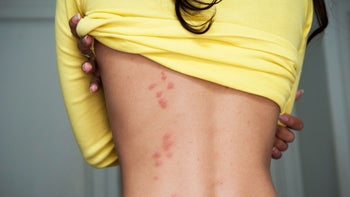
What Is a Pinworm Infection, and Who Gets It?
Key takeaways:
A pinworm is a parasite that commonly affects children and can cause anal itching at night.
Pinworm infections are spread easily between family members or people (especially children) that spend a lot of time together.
Anti-worm treatments and attention to personal hygiene are the two key ways to combat a pinworm infection.

Getting awakened by your child because of extreme anal itching can be alarming. But kids aren’t the only ones who can have these symptoms. Enterobius vermicularis, or pinworm, is often to blame. It’s a parasitic worm that needs to live in humans to reproduce and stay alive.
Pinworm infections are quite common and affect 40 million people in the U.S. and 30% of children worldwide. Once diagnosed with this infection, though, it’s easily treatable.
How do people get a pinworm infection?
A pinworm infection begins when you or your child accidentally swallows the microscopic eggs of the Enterobius vermicularis worm. Once the swallowed eggs reach the small intestine, they hatch and grow.
Here are some ways that you or your child can come in contact with pinworm eggs:
If you scratch your bottom and don’t wash your hands afterward.
If you don’t thoroughly wash your hands after bathing a child who has a pinworm infection. There’s a chance that these eggs can get in your mouth if you touch your face or handle food.
You can also accidentally swallow eggs on contaminated linens and clothes without knowing it.
Eggs can be transmitted from one person to another through sexual contact.
Rarely, someone can get a pinworm infection after inhaling an egg and then swallowing it.
You or your family can continue to infect yourselves (from scratching your bottom and transmitting the eggs to your mouth), keeping the vicious cycle of infection going. But if the eggs don’t reach a new human host quickly enough, they will dry out and die within 72 hours. However, they can sometimes live on clothing or other objects for a few weeks.
This infection doesn’t just happen at home, though. Working in a crowded environment can easily pass this infection around. This is why people who take care of institutionalized children, like those in orphanages or juvenile detention centers, have a higher chance of getting a pinworm infection. People who live in tropical climates are also at higher risk.
What do pinworms look like?
The chances you’ll actually see a pinworm with your naked eye are unlikely since they’re so tiny. But if you’re curious, they’re threadlike and whitish, and the females have a pinpoint tail. You won’t be able to see the eggs though, since they’re even smaller than adult pinworms.

What is the life cycle of a pinworm?
After growing into an adult pinworm — 1 to 2 months after the eggs first enter the body — they move on to their next home: the large intestine. Pregnant female worms then travel from the large intestine to their final destination: the anus (before being spread to other surfaces or people). This is where they spread their many thousands of eggs so that they have access to oxygen to mature.
Since they tend to take this journey at night, the itching is the worst at nighttime. This is thought to be an evolutionary survival tactic. If you’re fast asleep and not scratching, the eggs have time to mature without you getting in the way.
The worms can live in the body for a few months and continue mating and laying eggs. Rarely do larvae (baby pinworms) that hatch on the anus migrate back into the gut and begin the life cycle again.
What are the symptoms of a pinworm infection?
The most common symptom of a pinworm infection is itching around the anus (pruritis ani), especially at night.
Other common symptoms include:
Skin redness and warmth caused by a secondary bacterial infection (when itching breaks the skin)
Insomnia (not being able to fall or stay asleep) resulting from the nighttime itchiness, which can be debilitating
Rare symptoms include:
Abdominal pain
Weight loss
Nausea
Vaginal irritation or itching
But a third of people with a pinworm infection have no symptoms at all.
How do you know if you have a pinworm infection?
If you or your child has nighttime perianal itching, don’t be shy. Let your healthcare provider know, since it’s easily treatable.
Once your healthcare provider has made sure there isn’t another cause for your symptoms (see below), they will likely do what’s called a tape test, also known as a paddle test. It involves placing the adhesive side of tape on the anal area, and then examining the tape under the microscope for eggs.
Since it’s best to do this test right after waking up in the morning (shortly after the adult females lay their eggs), your healthcare provider may ask you to perform this test at home. You may have to repeat the test three to five mornings in a row to get enough samples to make sure you don’t have a pinworm infection. Samples from under the fingernails can also be examined under a microscope for the presence of eggs.
Is it a pinworm infection, or something else?
Perianal itching isn’t always caused by a pinworm infection. So, if you or your child have an itch down there, there are some other possible causes, including:
Cellulitis, which is a bacterial skin infection
Perirectal abscess, which is a pocket of pus around the anus caused by an infection
Anxiety and stress, which can cause some people to feel anal itching
Fecal soilage, which means there is stool (poop) around the anal area caused by not cleaning the area well
What are the best treatments for a pinworm infection?
So, your nighttime perianal itching is bad and your tape test turned out to be positive. What’s next? There are three medications used to treat pinworm:
Pyrantel pamoate. This is available without a prescription. You can buy it at a drugstore or online for about 10 dollars.
Mebendazole (Emverm). This is only available by prescription. In the United States it is not available as a generic. This means it can be very expensive, even if you have health insurance — up to $500 per pill.
Albendazole (Albenza). This is also only available by prescription. It can be expensive (up to $200) per dose, but it is also available as a lower-cost generic.
These medications kill the live pinworms, but they don’t kill the eggs. This means you will need to take precautions for the next 2 to 3 weeks so you don’t get reinfected. You should regularly wash your sheets and bedding, and disinfect toilet seats and other shared surfaces (like doorknobs, toys, and light switches). You should also wash your hands frequently, and cut your fingernails short. Towels, pajamas, and underwear should be washed after each use. Because it’s possible to get re-infected, adults and children over the age of 2 years may need to take a second dose 2 weeks after the first dose.
These medications also aren’t recommended for children under 2 years of age. Children in this age group don't tend to get this infection but, if they do, your child’s healthcare provider will discuss the risks and benefits of some of these medications. In other words, are the symptoms of the infection worse than the potential side effects of the medication to this age group? If so, they may recommend a medication taken at a lower dose.
Because a pinworm infection can spread within families, all members of the household should be treated at the same time. And if a child’s playmates or classmates are infected, they’ll need treatment, too. As long as reinfection doesn’t occur, the medication usually gets rid of the pinworm infection once and for all.
What happens if a pinworm infection goes untreated?
As long as you have a pinworm infection, you’re always at risk of spreading it to others, no matter how good your personal hygiene is. Here are a few other issues that can come up if a pinworm infection isn’t treated:
Continued autoinfection, which means you keep reinfecting yourself with the pinworm
Skin infections from repeated scratching, which can lead to micro-tears in the skin through which bacteria can enter
More serious and rare consequences, like appendicitis (an infection of the appendix, which is a part of the colon) and urinary tract infections
If you don’t get treatment and you don’t reinfect yourself or others, the infection typically resolves within 2 to 3 months, which is the normal lifespan of the worm. But it’s best to get treated right away to avoid any further issues from coming up — and so you can feel more comfortable.
How can you avoid getting pinworms?
This is easier said than done. Remember, pinworms are microscopic in size, so you can’t see them. Here are some ways you can prevent a pinworm infection:
Wash your hands. Rigorous hand hygiene practice is the best way to prevent getting a pinworm infection. Wash before eating or if you think you might have touched a contaminated item or person — and don’t skimp on soap or time.
Keep your and your children’s fingernails short. Do this so that eggs don’t get caught underneath your nails if you scratch your bottom, which can spread eggs to your mouth or other people.
Remind your children to not scratch around their anus or between their legs. Also, tell them to avoid sucking their fingers. The same is true for you.
Shower every morning if you’re infected. This will help remove any eggs on the skin from the worm migration the night before.
Frequently wash linens, clothing, and undergarments. After someone in the family gets diagnosed, washing can help prevent the infection from coming back another time.
Get the entire family treated at the same time. If you or a family member gets a pinworm infection, this is highly recommended.
Consider talking to your child’s teacher. Ask whether other children have reported having an infection, in which case it might be best for the entire class to be treated.
The bottom line
Although a pinworm infection is gross to think about and the itching is annoying, it’s usually not dangerous. But it does easily spread between people in a household, or between children and their playmates. And if the infection isn’t treated, it can continue spreading. Medications and hygiene measures can stop this human-dwelling parasite from an endless cycle and get you and your family back to comfortably sleeping again.
Why trust our experts?


References
Centers for Disease Control and Prevention. (2016). Pinworm treatment.
Centers for Disease Control and Prevention. (2020). Pinworm infection FAQs.
Centers for Disease Control and Prevention. (2020). Parasites - Enterobiasis (also known as Pinworm Infection).
Familydoctor.org. (2020). Pinworm infection.
Kucik, C.J., et al. (2004). Common intestinal parasites. American Family Physician.
Laurent, A., et al. (1997). Psychological assessment of patients with idiopathic pruritus ani. Psychotherapy and Psychosomatics.
MacPherson, D.W. (1999). Intestinal parasites in returned travelers. The Medical Clinics of North America.
Maizels, R.M., et al. (1993). Immunological modulation and evasion by helminth parasites in human populations. Nature.
Montresor, A., et al. (2002). Is the exclusion of children under 24 months from anthelmintic treatment justifiable? Transactions of the Royal Society of Tropical Medicine and Hygiene.
Rawla, P., et al. (2021). Enterobius vermicularis. StatPearls.
Reece, S.E., et al. (2017). The life and times of parasites: Rhythms in strategies for within-host survival and between-host transmission. Journal of Biological Rhythms.
Skinner, G. (2017). Pinworm treatments are an expensive drug mistake you don’t need to make. Consumer Reports.
Taghipour, A., et al. (2020). The neglected role of Enterobius vermicularis in appendicitis: A systematic review and meta-analysis. PLoS ONE.
Wendt, S., et al. (2019). The diagnosis and treatment of pinworm infection. Deutsches Ärzteblatt International.












